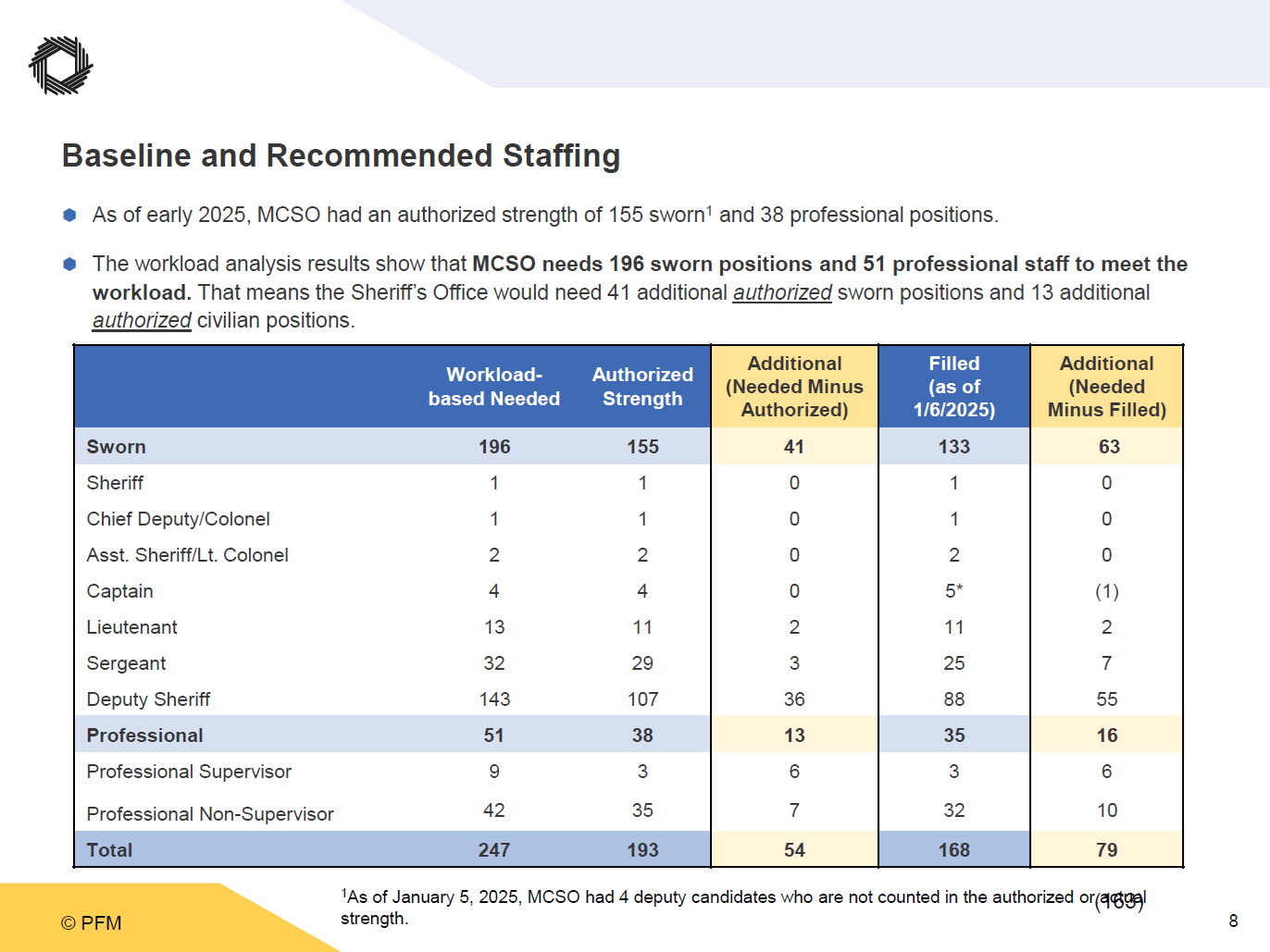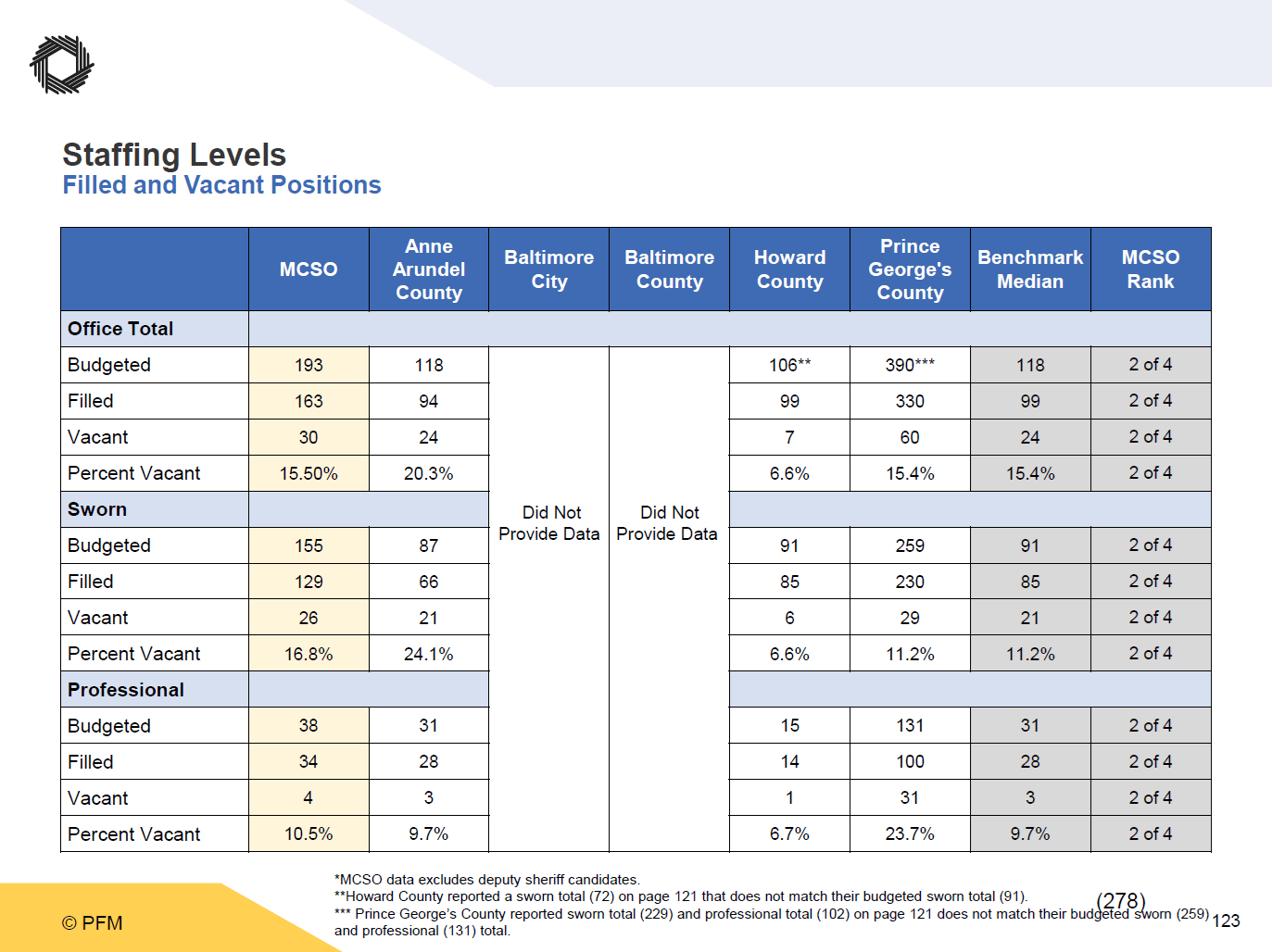By Adam Pagnucco.
Last month, I called for the county council to review staffing data on the sheriff’s office. The backdrop is a pending election for sheriff, in which the employee union (MCGEO) is supporting a challenger against incumbent Max Uy. The union claims that the office suffers from a variety of serious staffing problems. Uy acknowledges some difficulties but says they’re typical of law enforcement agencies both regionally and nationally. Who is right?
First, let’s quickly review the duties of the office. It handles important public safety functions related to domestic violence, courthouse security, service of summons and warrants, transporting inmates, responding to 911 calls and handling evictions. It is separate from the county’s police department and is led by an elected sheriff. Most Maryland counties don’t have police departments and rely on sheriff’s offices to handle all county-level law enforcement, but MoCo’s office is more specialized than most.
A new staffing report commissioned by Uy last year and now before the county council sheds some light on conditions at the office. Uy hired PFM Group Consulting LLC to “deliver a detailed workload-based staffing analysis to ensure the agency has a sound basis for evaluating current and future staffing effectively.” Uy’s contract with the consultant was initiated many months before the union declared its intention to defeat him. The report does some good work in illustrating the office’s challenges but doesn’t answer key questions necessary for voters to decide on Uy’s fitness for his job.
Here are a few key findings of the report.
The office is significantly understaffed.
Most vacancy data compares filled positions to authorized (budgeted) positions. This report goes farther by estimating how many positions are required to adequately handle the work of the office, a higher number than authorized positions. Here is the distribution of “workload-based needed,” authorized and filled positions by category.

The office has 193 authorized positions but had only 168 filled positions as of January, a gap of 25 positions (13%). (That filled position stat is now more than nine months old and the report lacks more recent data.) However, when compared to the 247 “workload-based needed” positions, the gap vs filled positions is 79 (32%).
If the report’s estimate of needed positions is anywhere close to accurate, that suggests the sheriff’s office has a funding shortage. It’s worth noting that the county council, not Uy, sets the office’s budget.
Staff shortages affect multiple functions.
PFM looked inside the office’s divisions and found many staffing problems. Here are a few statements in the report.
*****
On the Court and Transportation Section
MCSO [Montgomery County Sheriff’s Office] views its responsibilities to the courts as court-mandated and, as such, these functions take priority over other MCSO tasks. This frequently results in utilizing deputies from other MCSO divisions and sections to bolster daily staffing that appears to be insufficient to meet the baseline (existing) service level demands…
MCSO personnel reported that offering overtime to help fill shifts is less appealing because of the frequency of need, and some deputies indicated they experienced burnout. Combined, the personnel challenges and unpredictability in both scheduling and court demand harm employee morale.
On the Domestic Violence Section
Domestic Violence Section sworn personnel stated there was previously an overnight shift for deputies, which was eliminated within the past year due to staffing shortages. Currently, there is no overnight deputy coverage, although there is a sergeant on duty 24 hours per day, Monday through Friday.
Staff reported that reduced staffing on the weekends creates an operational challenge because court orders for protection orders, emergency evaluations, and other processes handled by the section can arrive 24/7 and are often time-sensitive, as a matter of public safety.
Sworn personnel reported that deputies are frequently pulled to provide coverage for courtroom security in the Courts and Transportation Section, which further depletes the section’s capacity…
Morale appeared to be negatively impacted by high workload and staff burnout, which may contribute to poor retention. Section personnel reported that staffing shortages are causing delays in serving orders and fulfilling court duties, with potential consequences for both individual and public safety.
On the Administrative Services Division
Assignment of both recruitment and training responsibilities to a single Lieutenant, combined with that Lieutenant being consistently detailed to Court Services to fill vacancies, can lead to bottlenecks in the recruitment application and background investigation approval process…
MCSO reported that it has not updated its testing materials in more than 20 years, which can lead applicants to form a poor impression of the Office (in particular, compared to other tests that candidates may be taking at other law enforcement agencies) and exit the application process.
*****
MoCo’s vacancy rate is not out of line with comparable sheriff’s offices.
PFM was able to obtain vacancy data in 2024 for four Maryland sheriff’s offices: Montgomery, Anne Arundel, Howard and Prince George’s counties. (All four counties also have police departments.) Overall, MoCo’s vacancy rate was lower than Anne Arundel, higher than Howard and almost the same as Prince George’s.

The report definitely depicts an office with problems. But it contains no historical data on whether staffing issues are getting worse on Uy’s watch. (An earlier council memo showed soaring overtime over the last few years.) It also does not suggest that MoCo is doing worse than its peers, although that was not its main focus.
As a result, it’s hard for voters to judge Uy’s performance in office based on this report alone.
That debate will now continue.
